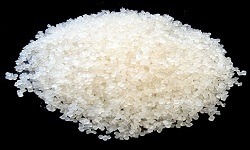IUPAC Name
Polyethylene
Cas Number
9002-88-4
HS Code
390110
Formula
(C2H4)n
Appearance
Semi-translucent, opaque, and waxy
Common Names
-
Packaging
25 Kg Bag
Linear low-density polyethylene is a substantially linear polymer with significant numbers of short branches, commonly made by copolymerizing ethylene with another monomer, such as hexene, octene, or butene, to give it the desired properties. It looks similar to HDPE but has lower crystallinity due to a more substantial number of short-chain branches. Therefore, it also has a lower density. LLDPE has many advantages over other types of plastic. It is lightweight, flexible, and durable, which makes it ideal for packaging applications. It is also resistant to chemicals, UV radiation, and weathering, which makes it suitable for outdoor use. Additionally, LLDPE also has good heat-sealing properties, which makes it an ideal material for packaging films. In the present-day scenario, Linear low-density polyethylene (LLDPE) has successfully replaced Low-Density Polyethylene.
The manufacturing process of linear low-density polyethylene (LLDPE) involves the copolymerization of ethylene with a comonomer such as hexene, octene, or butene. The process typically involves the following steps:
Ethylene and the comonomer are fed into a reactor under high pressure and temperature. The pressure is typically between 1000 to 3000 bar, and the temperature is between 120 to 300 °C.
A catalyst, which is typically a Ziegler-Natta catalyst, is added to the reactor to initiate the polymerization reaction. The catalyst helps to control the molecular weight and distribution of the polymer.
The ethylene and comonomer undergo copolymerization to form a molten polymer.
The polymer is then fed into a series of reactors where it undergoes further polymerization and chain growth. This process helps to improve the polymer's mechanical properties and control its molecular weight distribution.
After the polymerization process is complete, the polymer is cooled and solidified. It is then either pelletized or converted into a film or other forms.
Linear low-density polyethylene is a substantially linear polymer with significant numbers of short branches, commonly made by copolymerizing ethylene with another monomer, such as hexene, octene, or butene, to give it the desired properties. It looks similar to HDPE but has lower crystallinity due to a more substantial number of short-chain branches. Therefore, it also has a lower density. LLDPE has many advantages over other types of plastic. It is lightweight, flexible, and durable, which makes it ideal for packaging applications. It is also resistant to chemicals, UV radiation, and weathering, which makes it suitable for outdoor use. Additionally, LLDPE also has good heat-sealing properties, which makes it an ideal material for packaging films. In the present-day scenario, Linear low-density polyethylene (LLDPE) has successfully replaced Low-Density Polyethylene.
The manufacturing process of linear low-density polyethylene (LLDPE) involves the copolymerization of ethylene with a comonomer such as hexene, octene, or butene. The process typically involves the following steps:
Ethylene and the comonomer are fed into a reactor under high pressure and temperature. The pressure is typically between 1000 to 3000 bar, and the temperature is between 120 to 300 °C.
A catalyst, which is typically a Ziegler-Natta catalyst, is added to the reactor to initiate the polymerization reaction. The catalyst helps to control the molecular weight and distribution of the polymer.
The ethylene and comonomer undergo copolymerization to form a molten polymer.
The polymer is then fed into a series of reactors where it undergoes further polymerization and chain growth. This process helps to improve the polymer's mechanical properties and control its molecular weight distribution.
After the polymerization process is complete, the polymer is cooled and solidified. It is then either pelletized or converted into a film or other forms.
